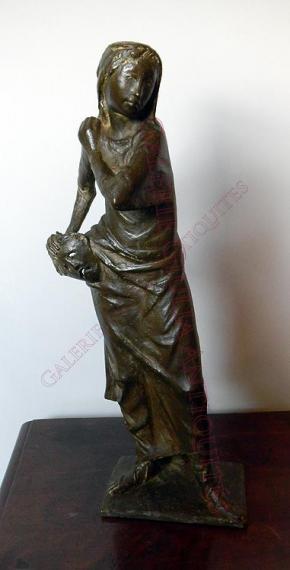Antonio Biggi - Bronze sculpture "Allegoria della Tragedia" (Allegory of Tragedy)
Submitted by Massimo Sarandrea on the 29th of March 2015
The sculpture is a clear representation of the figure of a classical tragedy, a woman dressed in old-fashioned with a peplum that holds a mask in her right hand, a symbol of the theatre.
The work is dated in the late '30s of the '900 in the middle of that season of great turmoil, both for the formal research, which in some cases still lingers on the contributions of the various Secessions and then Art Deco style, both for ideals that orients toward a return to the classic tradition. There is an approach with the “old” that is dictated by a kind of poetic inspiration, next to the lyricism drawn from profound understanding of an ancient feel, which transcends every age.
There is an obvious research of classical canons that manifests itself in the composition of the face and other compositional elements of the sculpture.
Antonio Biggi studied at the Academy of Fine Arts in Carrara, then moved to Genoa; in 1929 he arrived in Rome, called to collaborate in the great enterprise of the Foro Mussolini, probably by the president of the Opera Nazionale Balilla, Renato Ricci. From this experience, will come to life the figures of athletes which characterize the production of the period. In 1930 he won the Clementino competition organized by the Academy of St. Luke with the work Christ carried to Calvary. In this period he is affected of the influence of Francesco Messina, especially in fresh naturalness of his figures, which he exhibited in various Italian venues.
From 1934 to 1940 his reference point becomes Adolfo Wildt. In reality, however, the search for poetic of Biggi cultivates the need to experiment with languages other sculptors active in the period, from Marino Marini to Martini, to Fazzini, to Manzu, searching in all a common austere character, closed in on itself. In 1936 at the Venice Biennale, he exhibited the plaster Squadrista; in 1939 participates in the III Rome Quadrennial with the plaster Man who eats. In 1949 he won the gold medal in the competition for the doors of St. Peter, for which executes the bas-reliefs just outlined.
In the mid-fifties he was appointed professor of sculpture at the Academy of Fine Arts in Naples and at the same time he is an honorary professor at the same time at the Academy of Carrara where he will became director.
During the fifties one of his favourite themes become the little horses, taken from Greek vase painting, threadlike and evanescent. He continues to receive numerous public commissions, the latest of which a Christ and an Apollo and the Muses in 1961.


